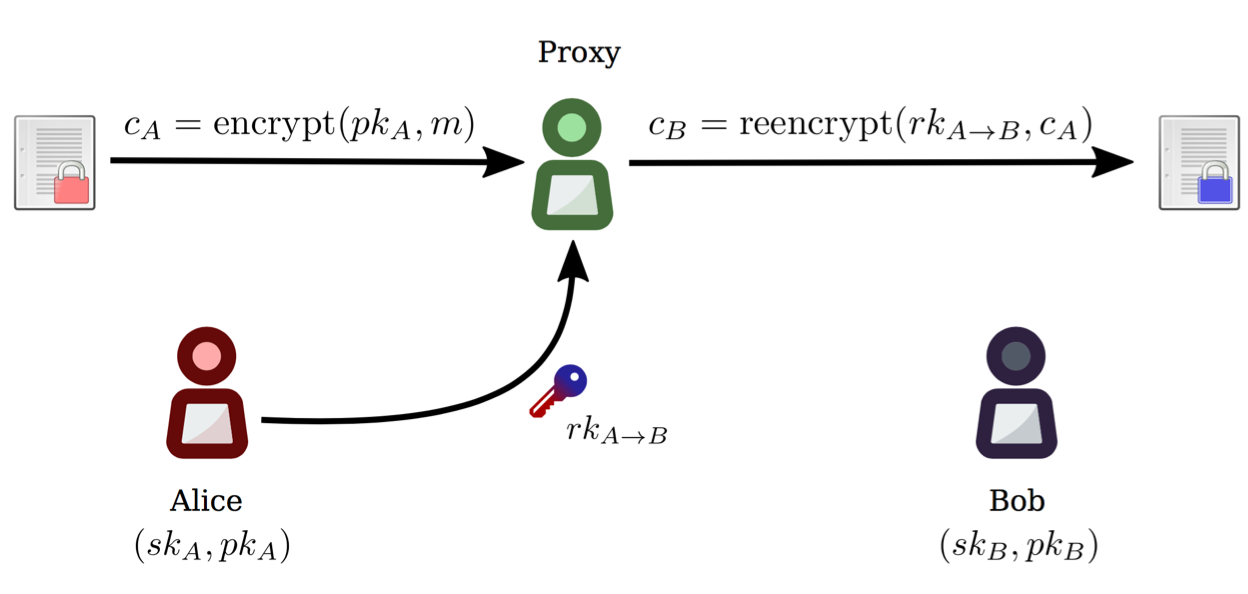Using pyUmbral¶

Elliptic Curves¶
The matter of which curve to use is the subject of some debate. If you aren’t sure, you might start here: https://safecurves.cr.yp.to/
A number of curves are available in the Cryptography.io library, on which pyUmbral depends.
You can find them in the cryptography.hazmat.primitives.asymmetric.ec module.
Important
Be careful when choosing a curve - the security of your application depends on it.
We provide curve SECP256K1 as a default because it is the basis for a number of crypto-blockchain projects;
we don’t otherwise endorse its security.
We additionally support curves SECP256R1 (also known as “NIST P-256”) and SECP384R1 (“NIST P-384”), but they cannot currently be selected via the public API.
Encryption¶
Generate an Umbral key pair¶
First, let’s generate two asymmetric key pairs for Alice: A delegating key pair and a signing key pair.
>>> from umbral import SecretKey, Signer
>>> alices_secret_key = SecretKey.random()
>>> alices_public_key = alices_secret_key.public_key()
>>> alices_signing_key = SecretKey.random()
>>> alices_verifying_key = alices_signing_key.public_key()
>>> alices_signer = Signer(alices_signing_key)
Encrypt with a public key¶
Now let’s encrypt data with Alice’s public key.
Invocation of umbral.encrypt() returns both a capsule and a ciphertext.
Note that anyone with Alice’s public key can perform this operation.
>>> from umbral import encrypt
>>> plaintext = b'Proxy Re-encryption is cool!'
>>> capsule, ciphertext = encrypt(alices_public_key, plaintext)
Decrypt with a private key¶
Since data was encrypted with Alice’s public key, Alice can open the capsule and decrypt the ciphertext with her private key.
>>> from umbral import decrypt_original
>>> cleartext = decrypt_original(alices_secret_key, capsule, ciphertext)
Threshold Re-Encryption¶
Bob Exists¶
>>> bobs_secret_key = SecretKey.random()
>>> bobs_public_key = bobs_secret_key.public_key()
Alice grants access to Bob by generating kfrags¶
When Alice wants to grant Bob access to view her encrypted data, she creates re-encryption key fragments, or “kfrags”, which are next sent to N proxies or Ursulas.
Alice must specify shares (the total number of kfrags),
and a threshold (the minimum number of kfrags needed to activate a capsule).
In the following example, Alice creates 20 kfrags,
but Bob needs to get only 10 re-encryptions to activate the capsule.
>>> from umbral import generate_kfrags
>>> kfrags = generate_kfrags(delegating_sk=alices_secret_key,
... receiving_pk=bobs_public_key,
... signer=alices_signer,
... threshold=10,
... shares=20)
Bob receives a capsule¶
Next, let’s generate a key pair for Bob, and pretend to send him the capsule through a side channel like S3, IPFS, Google Cloud, Sneakernet, etc.
# Bob receives the capsule through a side-channel: IPFS, Sneakernet, etc.
capsule = <fetch the capsule through a side-channel>
Bob fails to open the capsule¶
If Bob attempts to open a capsule that was not encrypted for his public key, or re-encrypted for him by Ursula, he will not be able to open it.
>>> fail = decrypt_original(delegating_sk=bobs_secret_key,
... capsule=capsule,
... ciphertext=ciphertext)
Traceback (most recent call last):
...
ValueError
Ursulas perform re-encryption¶
Bob asks several Ursulas to re-encrypt the capsule so he can open it.
Each Ursula performs re-encryption on the capsule using the kfrag
provided by Alice, obtaining this way a “capsule fragment”, or cfrag.
Let’s mock a network or transport layer by sampling threshold random kfrags,
one for each required Ursula.
Bob collects the resulting cfrags from several Ursulas.
Bob must gather at least threshold cfrags in order to open the capsule.
>>> import random
>>> kfrags = random.sample(kfrags, # All kfrags from above
... 10) # M - Threshold
>>> from umbral import reencrypt
>>> cfrags = list() # Bob's cfrag collection
>>> for kfrag in kfrags:
... cfrag = reencrypt(capsule=capsule, kfrag=kfrag)
... cfrags.append(cfrag) # Bob collects a cfrag
Decryption¶
Bob checks the capsule fragments¶
If Bob received the capsule fragments in serialized form, he can verify that they are valid and really originate from Alice, using Alice’s public keys.
>>> from umbral import CapsuleFrag
>>> suspicious_cfrags = [CapsuleFrag.from_bytes(bytes(cfrag)) for cfrag in cfrags]
>>> cfrags = [cfrag.verify(capsule,
... verifying_pk=alices_verifying_key,
... delegating_pk=alices_public_key,
... receiving_pk=bobs_public_key,
... )
... for cfrag in suspicious_cfrags]
Bob opens the capsule¶
Finally, Bob decrypts the re-encrypted ciphertext using his key.
>>> from umbral import decrypt_reencrypted
>>> cleartext = decrypt_reencrypted(receiving_sk=bobs_secret_key,
... delegating_pk=alices_public_key,
... capsule=capsule,
... verified_cfrags=cfrags,
... ciphertext=ciphertext)